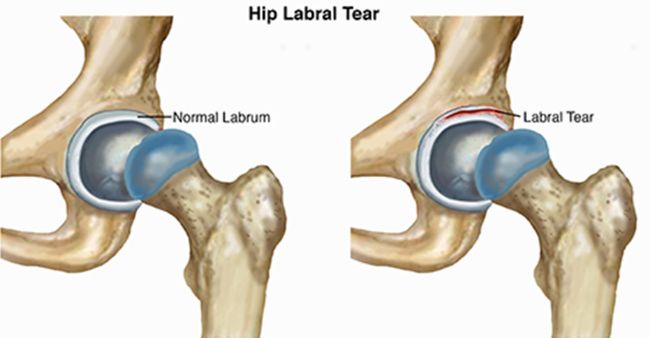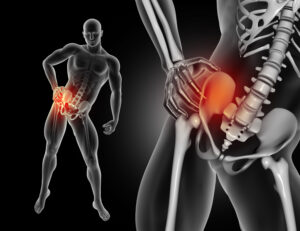The labrum, the soft tissue that covers the acetabulum (socket) of the hip, can become injured, and this is known as a hip labral tear. Injury, structural issues, or degenerative conditions can all lead to hip labral tears. Hip discomfort or stiffness are among the symptoms. In severe circumstances, surgery may be necessary to treat a hip labral rupture.

Overview
What is Hip Laberal tear?
Hip labral tears are frequently found in individuals engaged in specific sports or those with hip structural issues. If non-surgical methods prove ineffective, a healthcare professional might recommend surgical intervention to mend the torn labrum.
What are the types of hip labral tear?
Different types of hip labral tears can happen at various points along the labrum. Physicians often classify these tears as either anterior or posterior, depending on the area of the joint affected:
- Anterior hip labral tears: This type is the most prevalent and occurs at the front of the hip joint.
- Posterior hip labral tears: These tears happen at the rear of the hip joint.
Symptoms & Causes
Symptoms
When the labrum suffers injury, individuals may notice following signs:
- Pain in the hip or groin area
- Reduced flexibility or stiffness in the hip joint
- Sensations of locking, clicking, or “catching” in the hip joint
Additional symptoms, often linked to hip dysplasia or hip impingement, comprise:
- Stiffness in the hip, thigh, or groin
- Limited ability to flex the hip beyond a certain angle
- Hip instability
- A noticeable limp while walking
- Disparity in leg lengths
Causes
Causes of Hip Labral Tears
Hip labral tears can occur suddenly due to impact or develop gradually. They can affect anyone and are typically caused by:
- Repetitive hip motions and overuse, particularly common in certain sports and occupations.
- Traumatic hip injuries.
- Normal wear and tear on the hip joint.
- Hip joint deformities like hip dysplasia and irregular bone shapes leading to hip impingement, which increase strain on the labrum.
- Degenerative conditions such as osteoarthritis. The relationship between osteoarthritis and hip labral tears is reciprocal. Cartilage erosion from arthritis can contribute to labral tears, while labral tears can predispose individuals to arthritis development in the future.
Diagnosis & Tests
How are Hip Labral Tears diagnosed?
To ascertain if your symptoms stem from a hip labral tear, your physician may employ the following diagnostic techniques:
- Physical examination to evaluate indications of swelling and inflammation, assess your hip’s range of motion, and identify movements provoking pain.
- X-ray imaging to identify any irregularities in the hip joint’s shape or alignment, as well as signs of arthritis.
- MRI scan, with or without contrast material, to obtain a clearer view of the soft tissues surrounding the hip joint, including the hip labrum.
If the diagnosis of a labral tear remains uncertain after these tests, your doctor might suggest an ultrasound-guided injection with a pain-relieving agent. If pain relief occurs following the injection, it is likely that a labral tear is the underlying cause.
Is it possible for a hip labral tear to heal without intervention?
Hip labral tears typically do not heal without intervention. Nonetheless, if the tear is minor and not significantly painful or restricting mobility, it may be feasible to manage the symptoms without surgical repair.
Treatment for Hip Labral Tear
Non-surgical Approaches
Non-surgical strategies for hip labral tears focus on alleviating symptoms and preventing further damage to the labrum:
- Rest and modification of activities aim to minimize or eliminate movements that induce pain and worsen the injury.
- Over-the-counter medications like ibuprofen can assist in managing pain and inflammation.
- Injections into the hip joint with steroids and local anesthetics can provide temporary relief from pain and inflammation if over-the-counter medications prove insufficient.
- Physical therapy entails exercises designed to strengthen and stretch the hip muscles, enhancing their ability to support the joint and reducing pain during movement.
Surgical and Alternative Procedures
- Hip Arthroscopic Surgery: If non-surgical treatments fail to alleviate your symptoms, your healthcare provider may suggest hip arthroscopic surgery. This procedure involves the insertion of a fiber-optic camera and surgical instruments through small incisions in the skin.
- Surgical Hip Dislocation: Depending on the cause and severity of the tear, the surgeon may either excise the torn portion of the labrum or repair the damaged tissue by suturing it together.
Risks & Complications
Risks
While hip labral tears can affect anyone, certain conditions and activities heighten the risk:
- Individuals with structural hip issues like impingement, dysplasia, or lax ligaments have a higher likelihood of developing a hip labral tear over time.
- Engaging in specific activities involving repetitive or twisting motions raises the risk of a hip labral tear. These activities include ballet, golf, and swimming. Moreover, contact sports like football and hockey also increase the susceptibility to hip injuries, including hip labral tears.
Complications
Potential complications of surgery include infection, bleeding, nerve damage, and recurrence of symptoms if the repair fails to heal properly. Typically, returning to sports activities can take anywhere from 3 to 6 months post-surgery.
